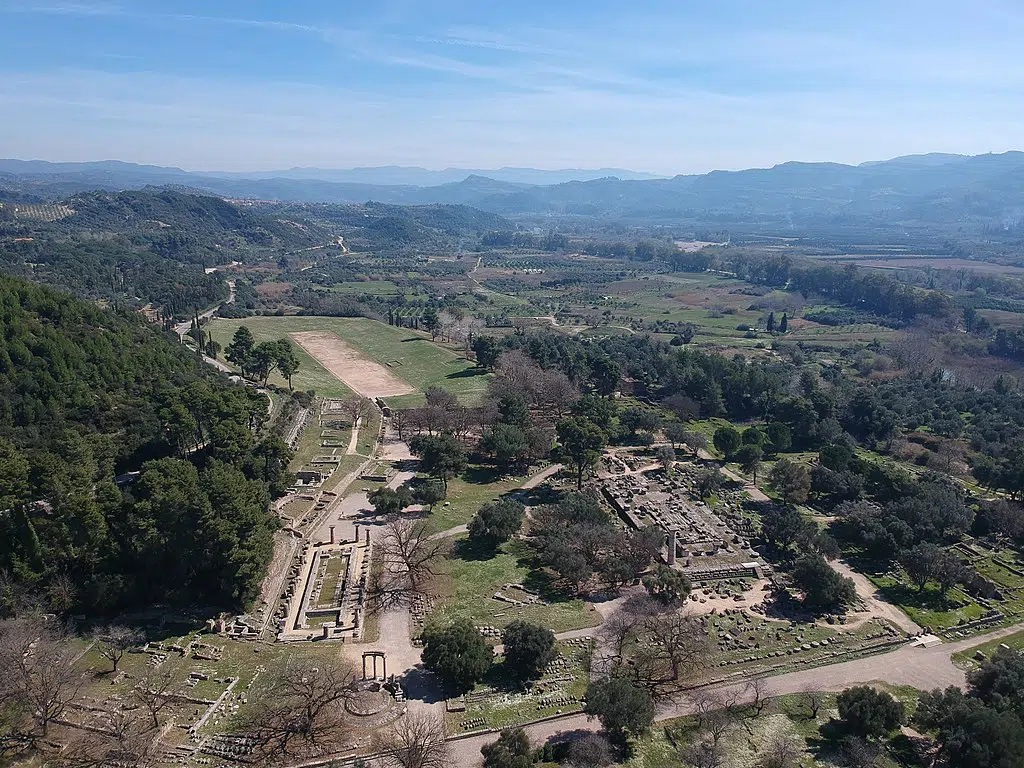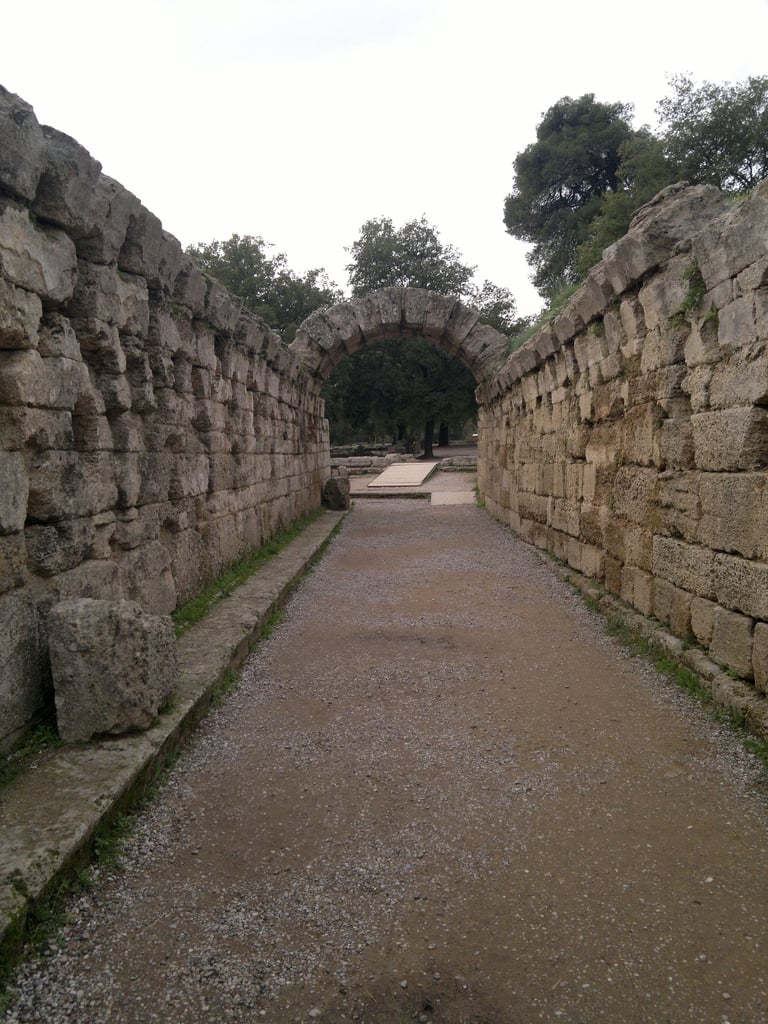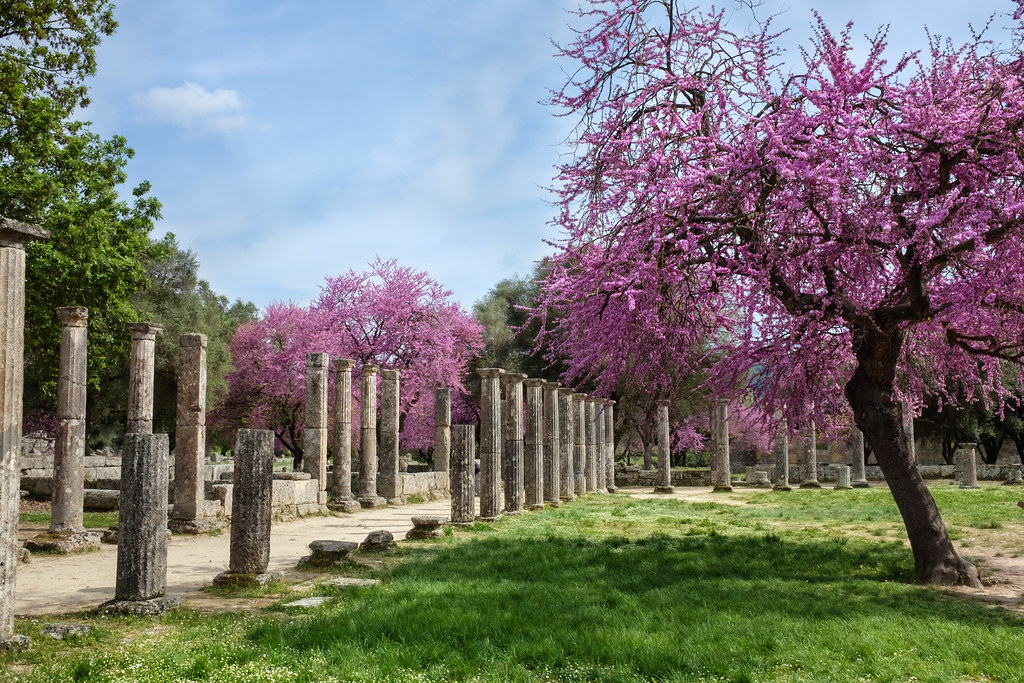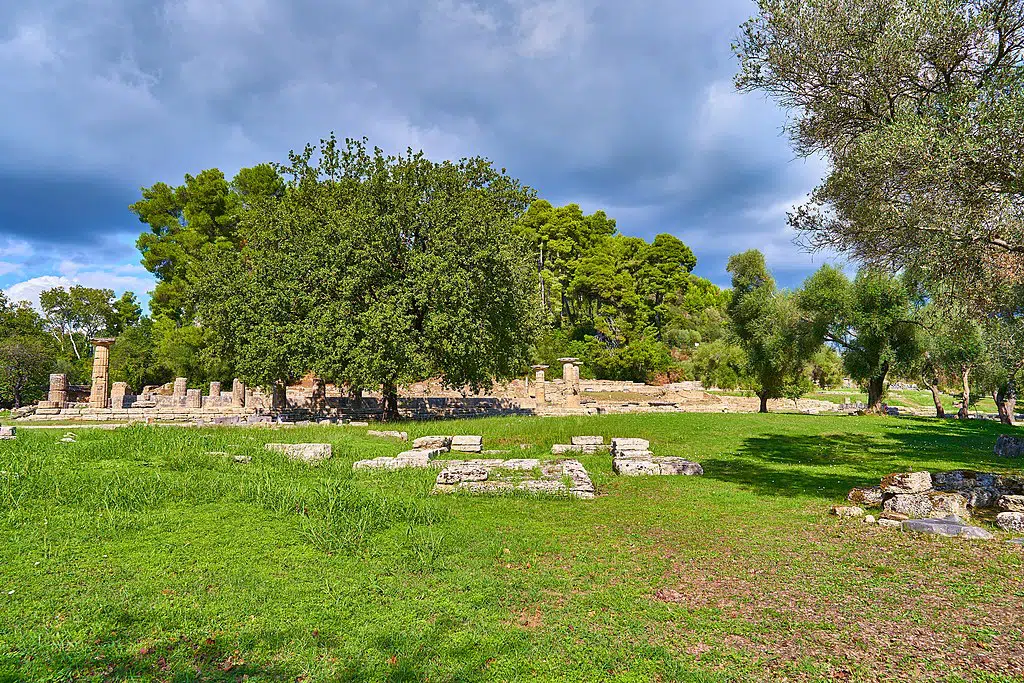
The sanctuaries and temples of ancient Olympia are some of the oldest and most important in all of Ancient Greece. Forming the backdrop to so much of Greek history, it is impossible to imagine Greece at all without Olympia, with its Games every four years dedicated to the king of all the gods, Zeus.
With temples dedicated to Zeus, Hera and Nike, treasuries, baths, gymnasiums, and stadiums, Ancient Olympia served as what one historian says was the “physical and metaphorical common ground” of Ancient Greece.
Archaia Olympia (Modern Greek: Αρχαία Ολυμπία; Ancient Greek: Ἀρχαίὰ Ὀλυμπία; “Ancient Olympia”), was a major Panhellenic religious sanctuary in the time of ancient Greece, where the Olympic Games were held every four years throughout Classical antiquity, from the 8th century BC to the 4th century AD.
The most sacred area of the site, named the Altis, was primarily dedicated to Zeus, although other gods were worshipped there, including his consort, Hera. The Games dedicated to him at Olympia drew visitors from all over the Greek world; it was the primary site of several “Panhellenic” centers which would host such festivals, which helped form the identity of the ancient Greeks as a people.
Olympia was home to more than 70 buildings at its apex
Historians believe that the Altis, an enclosure with a sacred grove, open-air altars and the tumulus of King Pelops, was first formed during the tenth and ninth centuries BC, known as Greece’s “Dark Age,” when the followers of Zeus had joined with the followers of Hera.
At its time of greatest glory, ancient Olympia was home to more than 70 buildings of major historical importance; thankfully, the ruins of many of these still survive today. This includes the Pelopion, the tomb of the quasi-mythical king Pelops, who was known as the ancestor of the Atreids, the two kings who led their peoples to war against Troy; he is the namesake of the Peloponnesian peninsula.
Along with the ruins of the imposing temples dedicated to Zeus and Hera, visitors to Olympia today can even see the ancient stadium from which all other stadia today take their names. The stadium and all the other buildings of ancient Olympia are as intact as they are thanks to having sat undisturbed for centuries under alluvial deposits after the area was flooded.

Ancient Olympia may have flooded due to tsunami, encasing area in silt for a millennium
Due to its proximity to the sea, and the presence of mollusk fossils found in excavations there, experts now believe that the area may very well have been flooded by a tsunami.
After the abandonment of the site after the triumph of Christianity, along with invasions and earthquakes, the area was completely abandoned in the sixth century. Eventually the entire site was covered by alluvial deposits of up to an incredible 8 meters (26 feet) deep.
Thanks to this fact, what was left of the temples, treasuries and other buildings of ancient Olympia — including even the stadium — was recoverable as soon as the site was identified and excavated in the 1700s and 1800s.
Although not much more than a delineated space with transverse curbing, the stadium was indeed the very site where athletes once marched in procession under an archway — which also, incredibly, still exists.

The Altis, or sacred grove, home to temples of Zeus, Hera and Pelopion
Once in the stadium, the athletes would be watched by spectators who sat mainly on the field’s sloping flanks. The length of this field became the standard stadion, an ancient Greek unit of distance. The stadium has now been resurrected for Olympic use with no major alteration of the ancient topography, with movable stands which do not damage the ancient grounds.
The Altis was an irregular quadrangular area measuring more than 183 meters (200 yards) on each side and walled, except to the North, where it was bounded by Mount Kronos.
The name Altis comes from a corruption of the Elean word also meaning “the grove” because the area was wooded, with olive and plane trees in particular.
This consisted of a complex of buildings, the most important of which are the Temple of Hera (or Heraion/Heraeum), the Temple of Zeus, the Pelopion, and open sites used for traditional activities, such as the area of the great altar of Zeus, where the largest sacrifices were made.

Monuments to family of Alexander the Great, treasuries, hippodrome were among the notable buildings at Olympia
According to the historian Pausanias, there were over 70 temples in total, as well as treasuries, altars, statues, and other structures dedicated to many deities. In contrast to Delphi, situated on the slopes of Mt. Parnassus, where a similar large collection of monuments were tightly packed nearly atop one another, Olympia sprawled beyond the boundary wall, with extra areas devoted to Olympic Games contests.
To the north of the sanctuary can be found the Prytaneion and the Philippeion, as well as the array of Treasuries representing offerings from the various city-states. The Metroon lies to the south of these treasuries, with the Echo Stoa to the east. The hippodrome and later stadium were located east of the Echo Stoa. To the south of the sanctuary is the South Stoa and the bouleuterion, whereas the palaestra, the workshop of Pheidias, the gymnasion, and the Leonidaion lie to the west.
The Temple of Zeus was built in the mid-5th century BC. It was the very model of the Classical Greek temple of the Doric order. Its size, scale and ornaments were beyond anything previously constructed on the site. The gigantic chryselephantine (ivory and gold on a wooden frame) statue of Zeus was the cult image in his temple. The Temple was built atop what had already served as an even more ancient religious site at Olympia.
The statue was so imposing and was so exquisitely made that it was known as one of the wonders of the ancient world. Created by Phidias, the master sculptor who made the statue of Athena Parthenos inside the Parthenon, it also was a massive, monumental work which was imbued with great majesty.
Incredibly, the workshop of the sculptor, including tools used by sculptors, was uncovered at Olympia in the 1950’s, almost as if it had been arrested in time. Although the workshop had been turned into a Christian basilica before the area was abandoned, its main function was still evident.

The classical Pelopion was a separate sanctuary defined by a peribolos wall dating to the 6th century BC, long after the institution of the Olympic games, in 776 BC. This was certainly a remodeling of a previously existing sanctuary of Pelops. The peribolos wall is still extant, as can be seen above.
A 1987 excavation of the Pelopion showed what archaeologists say was continual evidence of ceramics there from the 11th century BC onward, including from pre-Mycenaean times (1100-1000 BC) and the pre-Geometric era (1000-900 BC).
The researchers also found a great deal of cultic offerings as well, including votive figurines and vases.
First Olympics held in 776 BC
The first Olympic festival was organized on the site by the authorities of Elis in the 8th century BC – with tradition dating the first games at 776 BC. It was more than one hundred years later, however, that building were constructed at Olympia, with the earliest evidence of building activity dating from around 600 BC.
The Temple of Hera was constructed at this time; the Treasuries and the Pelopion were built during the course of the 6th century BC. The secular structures and athletic arenas, including the Bouleuterion, were also under construction during this period.
The first stadium was constructed around 560 BC, consisting of a simple track. The stadium was remodeled around 500 BC with sloping sides for spectators and shifted slightly eastward. Over the course of the 6th century BC a range of sports were added to the Olympic Games.

The legend for the site map is as follows:
1. Northwest Propylon; 2. Prytaneion; 3. Philippeion; 4. Temple of Hera; 5. Pelopion; 6. Nymphaeum of Herodes Atticus; 7. Metroon; 8. Treasuries; 9. Crypt (arched way to the stadium);10. Stadium; 11. Echo Stoa; 12. Building of Ptolemy II and Arsinoe II Treasuries; 13. Hestia stoa; 14. Hellenistic building; 15. Temple of Zeus;16. Altar of Zeus; 17. Ex-voto of Achaeans; 18. Ex-voto of Mikythos; 19. Nike of Paeonius; 20. Gymnasion; 21. Palaestra; 22. Theokoleon; 23. Heroon; 24. Pheidias’ workshop and paleochristian basilica; 25. Baths of Kladeos; 26. Greek baths; 27. Hostels; 28. Hostels; 29. Leonidaion; 30. South baths; 31. Bouleuterion; 32. South stoa; 33. Villa of Nero.
I. Sicyon IV. Byzantium(?) VII. Unidentified X. Metapontum
II. Syracuse V. Sybaris(?) VIII. Altar(?) XI. Megara
III. Epidamnus(?) VI. Cyrene(?) IX. Selinunte XII. Gela
The Golden Age of Olympia
The classical period, between the 5th and 4th centuries BC, was the golden age of Olympia, with a wide range of new religious and secular buildings erected, along with other structures.
The Greek Baths and other sports facilities, including the final iteration of the stadium, and the hippodrome, which hosted chariot racing, were constructed at that time. The Prytaneion, the building where the officials and winners of the Olympic Games met, was built at the northwest side of the site in 470 BC.
In the late classical period, further structures were added to Olympia, including the Metroon, which was constructed near the Treasuries around 400 BC. The erection of the Echo Stoa, around 350 BC, separated the sanctuary from the area of the games and stadium. The South Stoa was built at the southern edge of the sanctuary at approximately the same time.
The late 4th century BC saw the construction of the Philippeion, an Ionic circular memorial in limestone and marble. Its tholos contained chryselephantine (ivory and gold) statues of Philip of Macedon’s family: himself, his son Alexander the Great, his wife Olympias, and his other children Amyntas III and Eurydice I.
It was created by the Athenian sculptor Leochares in celebration of Philip’s victory at the battle of Chaeronea in 338 BC. This was the only structure inside the Altis that was dedicated to a human being.
Around 300 BC the largest building on the site, the Leonidaion, was built, in order to house important visitors to Olympia. Due to the increasing significance of the games, additional athletic buildings were constructed, including the Palaestra, in the 3rd century BC; the Gymnasion, in the 2nd century BC; and bath houses, around 300 BC.
Finally, in 200 BC, the vaulted archway linking the entrance of the stadium to the sanctuary was erected.
The decline, destruction, abandonment — and preservation — of Olympia
In the 3rd century BC, ancient Olympia suffered major damage from a series of earthquakes. Invading tribes who swept through the area in 267 AD led to the center of the ancient site being fortified with stones that had to be hurriedly taken from its monuments.
Incredibly, despite the destruction, the Olympic Games continued to be held at the site until the last Olympiad in 393 AD, after which the Christian emperor Theodosius I banned the Games, since they were dedicated to a pagan god. Archaeologists believe that the magnificent Temple of Zeus was destroyed around 426 AD, during the persecution of pagans in the late Roman Empire, following an edict by Theodosius II enforcing the ban on pagan festivals.
The site was then inhabited by a Christian community. Archaeological evidence suggests that Olympic events on a much smaller scale, perhaps with an overlay of Christianity, were still being held secretly until the Plague of Justinian, along with two earthquakes, devastated the site in the middle of the sixth century.
Ancient sanctuary complex at Olympia discovered under the silt in 1766
The site of the ancient sanctuary of Olympia, forgotten for more than one thousand years under the silt, was finally found in the year 1766 by the English antiquarian Richard Chandler. In May of 1829, a French team of archaeologists from the “Scientific Expedition of Morea” under the direction of Léon-Jean-Joseph Dubois and Abel Blouet, identified and partially excavated the Temple of Zeus for the very first time.
Since the 1870s, the excavation and preservation of Ancient Olympia has been the responsibility of the German Archaeological Institute at Athens. The first major excavation of Olympia began in 1875, funded by the German government.
The Olympic Games were revived in 1894 based on the ancient model, but were of course more international than they had been in the past. The new games turned to the site of ancient Olympia for their inspiration, where the magnificent ruins began to assume an even greater significance.
When Pierre de Coubertin, the founder of the International Olympic Committee, died in 1937, a monument to him was erected at ancient Olympia and, emulating Evangelis Zappas, whose head is buried under a statue in front of the Zappeion, de Coubertin’s heart was buried at the monument.
Revived Olympic Games harken back to illustrious past
The ancient idea of the Olympics, bringing together people in fellowship and celebration, still survives today. Now, the Olympic flame is lit by the reflection of sunlight in a parabolic mirror in front of the Temple of Hera and then transported by a torch to the place where the Games are being held.
When the modern Olympic Games came to Athens in 2004, the men’s and women’s shot put competition was held at the restored Olympia stadium, bringing the glory of ancient Olympia’s past to vivid life once more.
In March of 2021, archaeologists announced the discovery of a 2,500 year-old intact bronze bull idol near the temple of Zeus. According to archaeologist Zaharaoula Leventouri, one of the statue’s horns stuck to the ground after the heavy rainfall and carefully removed from the area. Researchers also revealed the further discovery of fine pottery there dating back to Greece’s Geometric period.
Almost all of the movable artifacts recovered from ancient Olympia can be viewed in one of the site’s three museums.
And now, thanks to a collaborative effort between the Greek Ministry of Culture and Sport and Microsoft, the stunning beauty of ancient Olympia has been recreated in full with digital technology.
Standing stones — albeit virtually — atop one another which long ago had been pulled down or suffered the ravages of time and nature, the new digital recreation of the site brings the glory of the ancient site to vivid life once more.
Greek Prime Minister Kyriakos Mitsotakis says in the new video presentation which accompanied the creation of the digital ancient Olympia, “The values of ancient Greece, I think, today are as relevant as they will ever be; it is the birthplace of democracy.
“Technology is opening up a completely different way of experiencing what our cultural heritage is all about and the project of Olympia is so important because it demonstrates the power of technology, the ability to not just look at the site itself but also to look at the lives of people, how society is organized. Being able to reintroduce Ancient Greece to the world by using technology … is a fantastic opportunity. The cultural applications will be literally endless.”
See all the latest news from Greece and the world at Greekreporter.com. Contact our newsroom to report an update or send your story, photos and videos. Follow GR on Google News and subscribe here to our daily email!



